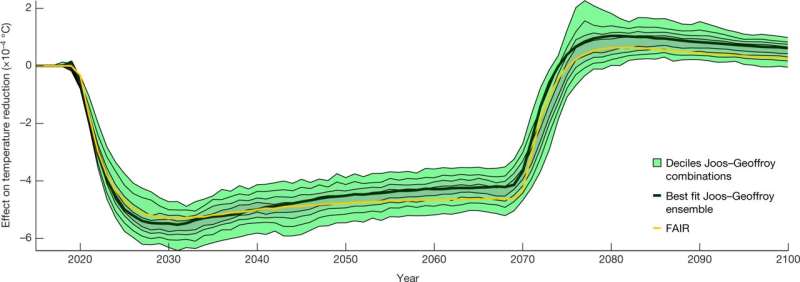This article has been reviewed according to Science X's editorial process and policies. Editors have highlighted the following attributes while ensuring the content's credibility:
fact-checked
peer-reviewed publication
trusted source
proofread
Researchers calculate economic value of temporary carbon reduction with 'social value of offsets' formula

A new study identifies how to calculate the economic value of temporarily reducing carbon emissions through carbon offsetting.
The social value of offsets (SVO) is an economic framework that will help policymakers calculate how much carbon should be stored in temporary offsets to make it equivalent to a permanent CO2 emission.
Using the SVO metric the researchers estimate that an offset sequestering one ton of carbon for 50 years is equivalent to between 0.3 to 0.5 tons permanently locked away, taking into account a range of factors for different risks, permanence and climate scenarios.
Offsets are a key part of Paris-compliant net zero strategies, but many offsetting projects fail and there is never a guarantee on how long an offset will sequester carbon for—making it difficult to measure the economic damage avoided.
The study, published in Nature, sets out the risks and uncertainties of offsetting, which occur due to the unregulated nature of the global offsets market.
Risk factors to projects in tropical forests, for example, can include the lack of strong institutions on the ground to monitor, enforce and account for emissions sequestered, as well as the possibility of fires and disease.
There are also risks in how emissions reductions are reported as well that of 'non-additionality'—when emissions reductions would have happened irrespective of the offsetting.
Other frameworks count the physical units of carbon but SVO is unique in that it is an economic framework where the value of temporary emissions reductions is measured as the value of the damages avoided to the economy during the length of the offsetting project.
The researchers say this will potentially make it easier to compare offsetting schemes, allowing anyone offsetting their carbon emissions to be able to weigh up the risks involved and decide how much carbon they would need to offset in temporary schemes to make up for a permanent carbon emission.
Professor Ben Groom, Dragon Capital Chair in Environmental Economics at the University of Exeter Business School, said, "Our analysis shows that a carbon emission today which is offset by a temporary project can be thought of as a postponed emission with the same warming effect when the project ends, but with less warming during the project.
"The Social Value of Offsets (SVO) stems from the value of delaying emissions and damages, and this depends on how impermanent, risky or additional they are. Valuing offsets using the SVO then provides a means of comparing offsets with different qualities in terms of the economic damages avoided."
Professor Groom explains why delaying emissions is important, both in an economic and physical sense. "With a project that stores carbon and releases it 50 years later, the net carbon reduction is always going to be zero, so some may say it's as if it never happened."
"But what that ignores is the flow of damages that you've avoided in the meantime, which could be important, because certain responses to climate change, like the melting of the ice caps, are responsive, depending on how long temperatures have been at a particular level."
"Delaying emissions is also important because economic processes could be happening in the background that make carbon removal cheaper in the future so offsetting could act as a temporary solution allowing the action point to be delayed until a time when it is cheaper to act."
"The question we're answering with SVO is how valuable this temporary period in which you avoid damages is."
The IPCC has previously noted that meeting the objectives of the Paris Agreement will require some offsetting, though some organizations suggest that offsetting should be largely avoided due to the unregulated, impermanent and risky nature of the offset market.
However, this study illustrates that in principle delaying emissions, even when offsetting projects are temporary and risky, is valuable in economic terms.
The economists believe the SVO metric can play an important role in appraising net-zero climate policy and harmonizing the offset market, and has policy applications beyond the valuation of offsets.
These include calculating the benefits-to-cost ratio of an offset or any temporary carbon storage solution allowing for comparison to alternative technologies for mitigating climate change.
The SVO formula can also be applied to Life-Cycle Analysis of biofuels as well as used to calculate the price of carbon debt, using the rule of thumb that a company that emits a ton of carbon today and commits to a permanent removal in 50 years' time will pay 33% of the carbon price today to cover the damages of temporary atmospheric storage.
More information: Ben Groom et al, The social value of offsets, Nature (2023). DOI: 10.1038/s41586-023-06153-x
Journal information: Nature
Provided by University of Exeter





















